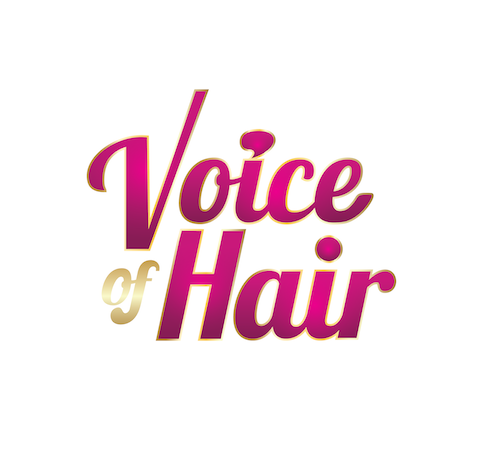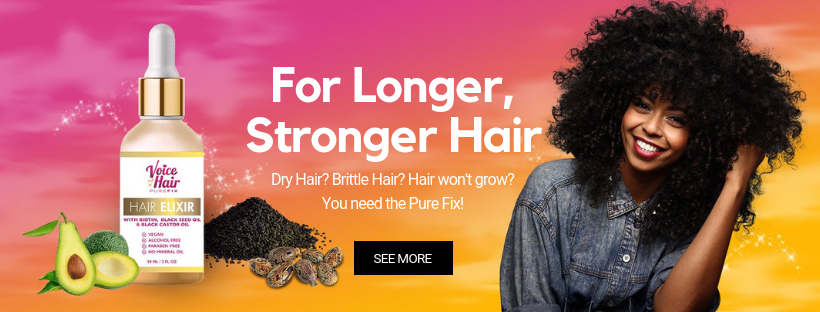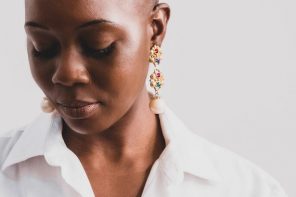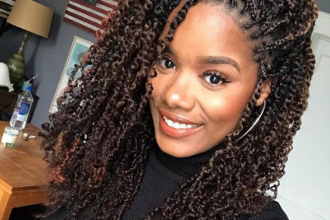“How can I get my hair to grow?” “Girl, do you have any tips on how I can get some length on my hair?” “No matter what, I cannot seem to get my hair to grow, and grow healthily.”
Nearly every day, I get an email, DM (direct message), or call from someone asking me about how to grow their hair. I get questions like the ones above all of the time. Well, if you have similar questions, then you are in the right place because in this post I am going to explain The 4 Stages of Hair Growth and What You Need to Know to Reach Your Hair Goals.
What is Hair and How Does it Grow?
It is important to know the stages of hair growth because once you know them, then you can identify where you are in your hair growth journey and go from there. But let’s begin by talking about what hair actually is because that will give you some insights into how it grows.
Your hair is made of a protein called keratin. Hair grows on human skin in various textures, colors, and density. A follicle is the structure from which each hair grows. Muscles, oil glands (sebaceous glands), and nerves extend from the follicle into the next layer of the skin—the dermis. Hair follicles, which are comprised of something called a hair bulb, anchor each hair into the scalp. In the hair bulb, living cells divide and grow to build the hair shaft. At the same time, blood from your vessels nourish the cells in the hair bulb, and deliver hormones that modify hair growth and structure at different times of life.
So, in other words, your hair begins growing from a root in the bottom of the follicle. The blood running through your scalp feeds the root, which essentially creates more cells and makes your hair grow. After being nourished properly, hair gets pushed up through your skin as it grows. In the process, your oil glands disperse oil into your hair which keeps it shiny and soft. However, too much oil can give your hair a greasy look and feel.
Stages of the Hair Growth Cycle
Now that you have a basic understanding of what hair is and how it grows, let’s talk about the stages of hair growth.
Your hair grows in cycles. In total, there are 4 stages to this cycle:
- The Growing Stage
- The Intermediate Stage
- The Resting stage
- The Shedding stage.
Let’s look at each stage and in doing so, discuss what is happening during each stage.
#1 ANAGEN (GROWING) STAGE
Each hair in your scalp grows at its own rate. That is not to say, however, that your hair cannot and does not grow together. The majority of your hair is often is the phase together. Your age, hormones, and overall wellbeing influences the way that your hair grows. With that said, a person can be in this stage for several years, almost up to a decade. Cells are constantly growing, dividing, and coming to the surface of your scalp. The factors above can influence your hair to grow at various rates, which again is influenced by the factors above. According to some research, your hair should typically grow about 1/2 each every month.
#2 CATAGEN (INTERMEDIATE) STAGE
During this phase of hair growth, the cells in your scalp are going back to their typical activity. As you recall, during the growing phase, the cell activity in your scalp was very active. The catagen stage is the intermediate period of hair growth because the older hair shaft breaks down and newer ones are produced in anticipation for the next round of growth.
#3 TELOGEN (RESTING) STAGE
The resting stage can span up to 1/4 of the year or 3 months. At this phase, your hair follicles no longer create new hair. Then, the dead hair in your scalp comes out through washing, brushing, and/or combing your hair. The newly grown hair replaces the dead hair. After your hair completes this stage, it is gearing up to go back into the growing phase.
#4 EXOGEN (SHEDDING) STAGE
According to research, you can lose up to 150 hairs from your scalp every day. But, remember, any number of hairs in your head can be in any of these stages at one time. So, shedding hair is a normal scientific process. However, if you are experiencing excessive hair shedding, then see a hair care practitioner (dermatologist or trichologist).
Throughout life, the skin is constantly shedding dead skin cells and growing new ones. This happens all over the skin. Inside the follicles, sebum (oil) carries the dead cells to the surface.
Other Important Factors
Various factors can interfere with the cycle of renewal and disposal, and a number of disorders can be the cause for hair not growing properly, including (but not limited to):
- Alopecia Areata: this discorder creates one or more patches of balding without any obvious change in the texture of the affected skin, a non-scarring alopecia.
- Cicatrial Alopecias (Scarring Alopecia): the inflammation that destroys the follicle is below the skin surface and there is usually no “scar” seen on the scalp.
- Inflammatory Alopecia: caused alopecia due to physical injury. Any physical damage to the skin such as burns or frostbite may cause localized alopecia.
- Traction Alopecia: Traction alopecia is similar to trichotillomania but occurs after using inappropriate hair styling techniques.
- Loose Anagen hair syndrome: People who have loose hair syndrome have hair that is easily pulled out by brushing or even by rubbing on a pillow at night.
- Congenital Triangular Alopecia: This form of hair loss is the result of incomplete skin development and differentiation at the temples.
- Aplasia Cutis Congenita: hair loss that result from incomplete embryonic skin development and is usually identified at birth.
- Alopecia due to neoplasms / cancer: Cancer in the skin can directly destroy hair follicles. Cancers elsewhere in the body may also indirectly affect hair fiber growth.
- Alopecia due to hemochromatosis: Most people know that iron deficiency causes hair loss, but not many people know that too much iron in the body is toxic and can also cause alopecia.
- Permanent surgery induced alopecia: Surgery can promote alopecia at the site of incision or, in some plastic surgery procedures, extensive alopecia can develop.
- Alopecia due to celiac disease: Failure to follow a gluten-free diet can lead to diffuse hair loss in celiac disease affected individuals.
Now What?
You are now better prepared to find the best products and treatments to help you with hair growth such as the VoiceOfHair PureFix Elixir which is an all-natural, vegan product that promotes growth, moisturizes hair, and stimulates your scalp.
If you found this helpful or know someone who is struggle with hair loss, then please help us share this message with as many people as possible and share with a friend or via social media.
This article was first published on June 5, 2018 and updated on February 2, 2021.
Latest posts by Brandelyn Green (see all)
- Everything You Need to Know About Moisturizing Oils Vs. Sealing Oils - February 15, 2024
- 4 Simple Tips To Slay Your Edges that You’ll Love - February 15, 2024
- 5 Benefits of Peppermint Oil That Will Make Your Hair Feel Like New - February 12, 2024











My hair will not grow. Maybe it is growing and it slow. I’ve been meaning it for over 6yr. I look at pic online and my hair is not grow like others. 6yr I don’t know what to do.
I am a senior ?with natural gray hair. Three different hair textures. Trying to find ?the best products for my hair types..that wouldn’t stain my white gray hair..naturally curly silky hair on the back and sides, top of my head the hair is a tight curly 4c or 3c.
Hi Marsha! We have some new products that will be launching next month! Be sure to sign up for our email list so you can stay informed.
Hi. My name is Lori I’m 47 and since 2005 I have a nf2 benige head surgeries and i am where all of my hair is thinning and i cannot get it to grow what do I do
Good Morning I’m Olivia Lashambae I have a bottle of your product, Thank you for sharing I have salt/ pepper hair my desire is to finally grow Locks I’ve thinning sides(near the temples) I’m using your product so I will remain patient because I want to go to a Good Lock Person to get my Locks started I desire the small Locks very tiny I shall continue to use your Product.
Hi Olivia,
Thank you so much for your comment and for being such a valued customer of ours!
We are thrilled to see your before and after pictures of your growth. If you ever have any questions, please
feel free to contact us at [email protected]